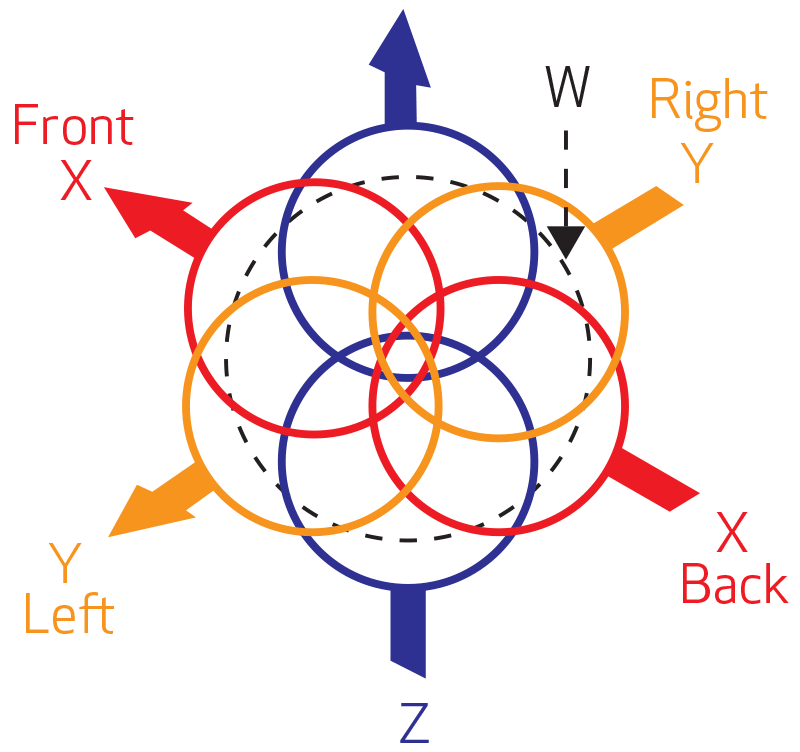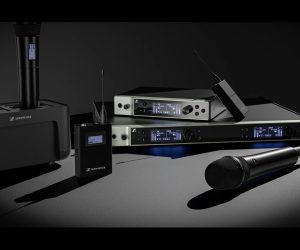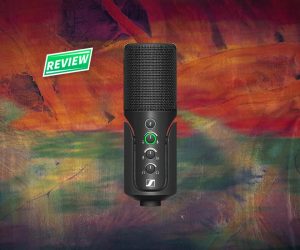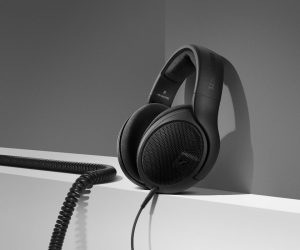
Sennheiser’s Slice Of Virtual Action
Sennheiser is preparing for a future where microphones can go anywhere, even into virtual worlds.
“VR could be the next 3D,” warned Simon Beesley, Sennheiser’s Manager Global Business Development for Broadcast & Media. If you haven’t kept up with screen tech in the last decade, that’s not a good thing. 3D died under a mountain of CGI action movies and 3D-‘enhanced’ detritus controlled by an unholy alliance between Hollywood and screen manufacturers looking to cash in quickly on ‘the next big thing’.
While Hollywood keeps its factory line of Avengers 3D movies trickling along, the tech industry, and many screen manufacturers have moved on to the next glittery toy: virtual reality. VR had basically been rubbish since Ivan Sutherland’s Sword of Damocles — the first head-mounted display (HMD) system that was so bulky it had to be suspended from the roof — right up to 2010, when a kid named Palmer Luckey turned a smartphone screen into a HMD with a wide 90° view. Then the big money came out to play. Facebook bought Luckey’s company, Oculus VR, for $2b in 2014. Then Sony announced Project Morpheus [check out our Issue 114 feature], Samsung showed off its GearVR, HTC and gaming company Valve collaborated on HTC’s Vive, and Google made a cardboard cutout for your phone.
There are many more corporations with a vested interest this time around. Beyond the major players, there are loads of ancillary companies putting a stake in the VR biz. At the low end of VR capture, companies like Nikon and Ricoh have small dual-lens VR cameras. More production-ready rigs include GoPro-style gizmos like Google’s Jump, Samsung’s Project Beyond, Nokia’s Ozo, Jaunt VR Studio’s own Neo rig, NextVR’s gargantuan RED camera rig, and VR content leader, Chris Milk’s company Vrse has its own system with integrated sound capture. On the more esoteric side — if there is such a thing in VR — non-traditional lightfield camera manufacturer Lytro has announced Immerge, and who knows what Magic Leap has up its sleeve. The company has raised almost a billion dollars with barely anything to show for it.
All of that is to say, other than Vrse’s rig, none feature more serious audio than a mono mic onboard.
While a lot of attention has been paid to acquiring VR vision, not many companies are developing tools for audio, which is where Sennheiser hopes to make a dent with its Ambeo umbrella of products.
One reason for the low uptick in VR audio technology is because we’ve actually had the means of capturing full-sphere surround sound audio, Ambisonics, well before VR vision became viable. It’s just been sitting on the shelf waiting for its release format to arrive [see Ambisonics box].


VR REVOLVES AROUND AGAIN
Sennheiser isn’t redefining the game here, its VR Mic features the same tetrahedral microphone design originally devised by Ambisonics’ inventors Michael Gerzon and Peter Craven. Manufacturing of tetrahedral mics has been the domain of specialist manufacturer SoundField, and small-batch enthusiasts like Coresound Tetramic and the Zoom H2n-attached Brahma. However, now that the patents have expired and the VR revolution is well underway, it’s perfect timing for the bigger players to start putting their weight behind the Ambisonics format.
“A lot of people in audio will know Ambisonics, but it was never mainstream,” said Beesley. “Ambisonics was potentially ahead of its time because there was no real market requirement for that spatialisation of audio. With immersive technologies like Atmos and Auro, and particularly VR, Ambisonics is coming into its own.”
If VR is to avoid the same fate as 3D, content creation needs to fulfil two criteria — quality and quantity. “If the quality is poor, people won’t adopt it,” Beesley pointed out. “It’s why we feel the audio part is really important, otherwise it’s not a realistic experience.”
VR is at an odd stage. While a first-class VR experience requires proper VR goggles and a high-end PC, the actual entry point into VR via Google’s Cardboard viewer for smartphones is incredibly low. You can even watch a non-stereoscopic version on your phone that still lets you spherically pan around the image while also getting the full binaural audio effect through your headphones. The distribution infrastructure for VR is already in place too; Facebook has implemented 360 video on its timeline and YouTube lets anyone deliver content to the mass market.
Still, VR ain’t that easy to produce, so more manufacturers taking the punt developing for the format will only make it easier and more affordable. Sennheiser’s first VR Mic — which will probably have a different name when it’s released in September — will cost around €1700 for the mic and software. It’s the sort of guide price that won’t bother a moviemaker with 16 GoPros, and will sit somewhere between the Tetramic and a Soundfield microphone. “We’re trying to bring this into the prosumer market and then look at taking it into the consumer market as well,” said Beesley. If VR takes off, the entry point for soundfield microphones will definitely fall.
For now, the Sennheiser VR Mic outputs four channels of analogue audio, which is decoded in the provided software. It has a svelte shockmount that allows it to be placed in the typical VR deadspot underneath a VR rig. Besides cheaper versions in the future, Sennheiser may also work on digital versions too. “This is Mark I. We’ll see where it goes,” said Beesley. “There are conversations being had about how to develop the technology in the future. Our main goal is to make spatialised audio as easy as possible for people. Because as soon as it gets complicated, people shy away from it.”

SPACE FOR PLUG-INS
Besides a big manufacturer like Sennheiser getting onboard the VR wagon, another sign that VR audio is being taken seriously is Facebook’s latest acquisition of Two Big Ears. Before the buyout, the company had been working on its Spatial Workstation software — a set of 3D audio spatialisation tools including AAX and VST Spatialiser plug-ins, VR video player, an encoder app, and template projects for compatible eight-channel bus DAWs (Pro Tools, Reaper and Nuendo).
The setup allows users to combine, mix, three-dimensionally pan and rotate independent tracks of various B-format audio conventions, spot mics, score, voiceovers, and any other content. It also includes real-time room modelling and everything you need to encode and deliver the multiple output formats you need for interactive 3D, and stereo and binaural previews.
Facebook has since released the tools free of charge (facebook360.fb.com/spatial-workstation), along with its guide to creating VR content.
Sennheiser has also been dabbling with its own spatialisation plug-ins under the Ambeo umbrella. The Venue Modelling VST plug-in will be available mid-year, and is initially designed to virtually place DJs and producers in a handful of specific clubs around the world allowing them to pre-experience their sets from the audience’s vantage point. It seems like a bit of a gimmick, especially when you consider the limited audience for a plug-in like it. However, it makes sense as part of Sennheiser’s overall 3D push. If VR takes off, being able to model performance venues could create an entirely new way of experiencing concerts remotely. There’s also no limit to how this technology could be applied in other areas of VR content creation.
GOING PRO
Not content to just go long on the VR business, Sennheiser has been looking further afield and developed some novel cameratop mics for the current crop of filmmakers. There’s the fork-tongued MKE440 stereo shotgun, which isn’t a configuration you typically come across. Its roughly 45-degree splay gives you a slightly wider spread than a typical mono shotgun, but without losing definition like a standard XY cardioid setup.
However, the most exciting piece of gear Sennheiser will shortly release is also its smallest. After evaluating the market, the mic manufacturer saw a big gap in the action mic category. There was just nothing there that could stand up to the abuse those cameras are subjected to.
“We were generally looking at different markets. The main one was people producing footage for Periscope and YouTube, and it became obvious to look at action cams,” said Beesley. “We decided to go for the biggest one, GoPro. One of the biggest GoPro end user complaints was the sonic quality. Because it’s quite an investment, the first thing people do when they buy a GoPro is put it into the protective waterproof housing. As soon as you do that you lose the ability to record decent quality audio.
“An awful lot of footage on YouTube is either dubbed over or set to music. We started the conversation with GoPro right at the point they were beginning to formulate their Developers Program to look at different accessories. They invited us to join their program on the audio side. They had a big launch in April with 100 developers and we’re the only audio developer in the program.”
The Action Mic is Sennheiser’s first foray into the action cam-specific market. The requirements were obvious, yet daunting. It had to be water resistant enough to dive with, wind resistant enough to handle the speed of a motorbike, and rugged enough for extreme environments.
“The mic itself is an omnidirectional electret capsule that’s been developed specifically for that microphone,” said Beesley. “The windshield is a new technology and unlike normal windshields. The dead ferret type of affair is very effective, but when they get wet the hairs lay flat and you lose effectiveness. This is a new type with stiffer filaments that don’t lie flat when wet.
“The major development in small electret microphones has been to make them sweat resistant for theatre and be able to clean makeup off the microphone without damaging the element. It was a progression from the technology we already have for sweatproofing our microphones.
“The membrane used on the surface of the element is acoustically transparent, but it also has a surface tension that doesn’t break the surface tension of the moisture drop. Therefore it’s impermeable to liquid; you can literally take it down underwater. Whenever you say a mic is waterproof, you have to be very careful; water resistance is probably a better term. Because of the nature of the membrane, if you dive deep with the microphone, the pressure can force water through the membrane. The microphone we’ve produced is not for deep sea diving, but certainly anyone doing water activities above a 10m depth should be absolutely fine.”
One of the benefits of being part of the Developer Program is access to GoPro’s preamp and circuit specifications without having to reverse engineer them. It allowed Sennheiser to craft the best possible response that matched the GoPro field of view with the most usable sensitivity. “We really thought about what people want to capture,” said Beesley. “Firstly, they want the environmental noise, the sound of the skis or wakeboard, but they also need the ability to hear what they’re saying. A lot of people put action sports on YouTube to show people what they’re doing and comment at the same time. With this, rather than having to mask it with music, they can put it straight onto YouTube with their own commentary and environmental sound, so people can get a more realistic experience from the video.”
In the same way that a stereo shotgun brings a new perspective to cameratop audio, Sennheiser will release other action mic variations in the future. “This is our first microphone,” said Beesley. “But there will be others in the range for GoPros.”
Hopefully having Sennheiser push the boundaries of where a mic can go will push other manufacturers to do the same.
















RESPONSES